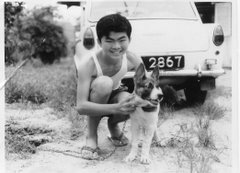I remember two movies that I saw at Sky.
 The first was the famous 射雕英雄传 (The Brave Archer). This is an extremely popular Wuxia classic that has been made to countless television serials. The movie version that I saw was produced by Shaw brothers and it starred the late Alexander Fu Sheng. I remember the pace of the movie was so fast that we had great difficulty following the story. I think it was unwise for the producer to try and cram such a long and well-know story into a single 2-episode movie.
The first was the famous 射雕英雄传 (The Brave Archer). This is an extremely popular Wuxia classic that has been made to countless television serials. The movie version that I saw was produced by Shaw brothers and it starred the late Alexander Fu Sheng. I remember the pace of the movie was so fast that we had great difficulty following the story. I think it was unwise for the producer to try and cram such a long and well-know story into a single 2-episode movie.As I think about this classic, I believe there used to be an even earlier black and white version of it; in Cantonese of course. Can anyone remember?
The other movie which I remember seeing at Sky theatre; and probably my last, was another Shaw Brothers sword-fighting movie by the title of 流星蝴蝶剑. The director was a new generation director by the name of Chor Yuen. What I remember about this movie was the sounds made by the swords when they clashed. It does not produce the usual metallic clanging sound but a very nice ringing sound.
I remember watching a show at Sky (probably 流星蝴蝶剑) with some colleagues from Philips. So the year has to be around 1980 or even later. Hence I find it rather strange that during the interview at the Channel News Asia Primetime Morning show the other day, Director Kelvin Tong kept saying that Great World closed down in 1978.
I also remember two movies at Globe. One was The Graduate which starred a very young Dustin Hoffman. I enjoyed the Simon and Garfunkel songs more than the movie itself. The other was an extremely dull movie titled Catch 22. It starred Art Garfunkel in one of his rare starring roles. I fell asleep midway through the show and cannot remember what the show was all about.
 Photo 1: Some of the faithfuls who made it to the gala premier
Photo 1: Some of the faithfuls who made it to the gala premier Photo 2: My friend Salleh who has four decades of professional movie camera experience since the days of Cathay-Keris Studio explained that nowadays with digital cameras, “Rolls” have been replaced by memory cards. You see “Cards” instead.
Photo 2: My friend Salleh who has four decades of professional movie camera experience since the days of Cathay-Keris Studio explained that nowadays with digital cameras, “Rolls” have been replaced by memory cards. You see “Cards” instead. Photo 3: Me a cinema addict? Some cinema tickets from Globe Cinema, Great World (c 1959, 1960, 1961).
Photo 3: Me a cinema addict? Some cinema tickets from Globe Cinema, Great World (c 1959, 1960, 1961). Photo 4: Left to Right - Some of the cast members take a break. Do you remember that lady in red polka-dot frock? Prop crew fixing the red banner to welcome Elizabeth Taylor; Camera Director is seated on the tulip which can swing and elevate in different directions.
Photo 4: Left to Right - Some of the cast members take a break. Do you remember that lady in red polka-dot frock? Prop crew fixing the red banner to welcome Elizabeth Taylor; Camera Director is seated on the tulip which can swing and elevate in different directions. Photo 1: Cut! Cut! Cut!
Photo 1: Cut! Cut! Cut! Photo 2: Great World’s Lye Ying Photo
Photo 2: Great World’s Lye Ying Photo  Photo 3: Give that look Dolly!
Photo 3: Give that look Dolly! Photo 4: Flamingo’s “Taxi Girls”. They can do the Cha Cha, Mambo and Rock n Roll for the price of $1. The girls were Chinese, Eurasians and sometimes Javanese girls and they stayed in shared accommodation at Bo Bo Tan Garden, Melody Mansion and Pacific Mansion (c 1960).
Photo 4: Flamingo’s “Taxi Girls”. They can do the Cha Cha, Mambo and Rock n Roll for the price of $1. The girls were Chinese, Eurasians and sometimes Javanese girls and they stayed in shared accommodation at Bo Bo Tan Garden, Melody Mansion and Pacific Mansion (c 1960). Photo 5: Yee Kuchea’s first shop Hoi Cheong (c 1950).
Photo 5: Yee Kuchea’s first shop Hoi Cheong (c 1950). Photo 1: Aerial reconnaissance over Singapore by “E group” of the Royal Air Force. Photo courtesy from Peter Stubbs Collection
Photo 1: Aerial reconnaissance over Singapore by “E group” of the Royal Air Force. Photo courtesy from Peter Stubbs Collection Photo 2: The cabaret at Great World (c 1945). The blue text indicates its original position and the red text the present.
Photo 2: The cabaret at Great World (c 1945). The blue text indicates its original position and the red text the present.



